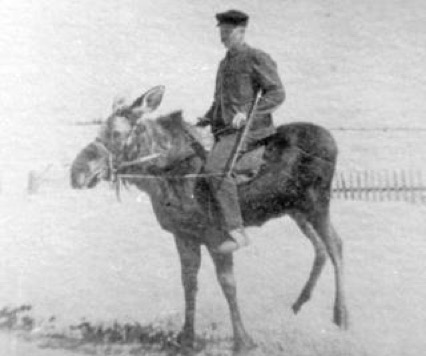HOWLEY
Experiencing the world, In your own style.
Moose History
Bartibog, Miramichi, New Brunswick, Canada, the story of the origin of Moose in Newfoundland and the man responsible, John Connell.
Traveling piggy-back style from Chatham, to Newfoundland.

In 1972, there were an estimated 40,000 moose in Newfoundland. Wildlife officials in the tenth province believe that since 1945, there have been more than 180,000 moose legally hunted.
The significance of those two statements may escape you unless you know that the ancestors of all those moose once roamed the Miramichi forests in the vicinity of the Bartibogue River.
Very well then, how did the moose get from the Miramichi to Newfoundland? Well, it's very simple. A group of men from the Bartibogue area lassoed the moose, tethered them on to sleds, and took them to Chatham to put them on the train.
The story of the capture of the live moose to stock the forests of Newfoundland is well known among older residents along the river. They have all heard versions of the story; most of them have heard of the man who led the hunt, the almost legendary John Connell.
John Connell has, apparently, more than one claim to fame. He's known for his tame moose "Tommy" (Tommy's original saddle is on display at the Miramichi Natural History Museum, Miramichi East, Wellinton Street) but perhaps he is best known for the feat he performed in that winter of 1904.
John was a guide of note in the forests around the turn of the century. He was a hunter and fisherman second to none and he knew the habits of the wild creatures in the Miramichi woods.
Moose Requested !
John Nowlan of Chatham, who was raised by Connell's nephew Mike, recalls hearing about the moose capture during his growing up years. He is not positive but he thinks the request for live moose must have come from the Newfoundland government.
"I don't know if anyone would remember that now, but I guess the impression we all had is that there was some definite request. I don't know why else anybody would go out and catch a live moose," John Nowlan says.
John thinks the men who were involved were paid $50 for each moose "That was a lot of money in those days!"
There was a lot of snow in the winter of 1904. Even in March, people have heard that the snow was four feet deep. This made it very hard for the moose to travel any distance and they were mainly confined to their "yards".
For that reason, John Connell and his collaborators had little difficulty finding a colony of moose. The men used snowshoes to go deep in the woods, the snow being to deep and heavy for their horses to negotiate. When they reached the moose, according to those who have heard the old stories, they formed a circle around them.
The Round-Up..."Then they lassoed them -- just like cattle," John Nowlan says. "The moose, of course, had no antlers at that time of year, and it's also the time of their least strength. Moose are thin in the late winter. They probably weigh a couple of hundred pounds less than they will in the fall after a summer of good feeding."
Having lassoed the moose, the men would tether it, and drag it out to where the horses waited with high-sided sleds. When they had captured six by this method, they removed their snowshoes and drove to Chatham (a distance of 10 to 12 miles) where they put the moose on the train.
Four Survived ?
John Nowlan seems to remember hearing that one of the moose died of fright at the station and perhaps another died in route. Reports seem to indicate that only four moose eventually arrived in Newfoundland -- two cows and two bulls.
Many years later, Jack Connell of Chatham (the great grandson of John Connell) received a press release from the Department of Tourism in Newfoundland. The release notes that the government had just come into possession of an early photograph showing one of the first moose to arrive in the province.
The release reads, in part: "The photo shows a yearling cow which was one of four moose released in the Howley area of Newfoundland in 1904, as an experimental attempt to introduce this species of big game animal to Newfoundland. The success of this project is now a matter of record, since the animal shown in the photograph became one of the original progenitors of a moose population currently estimated to be in excess of 40,000.
